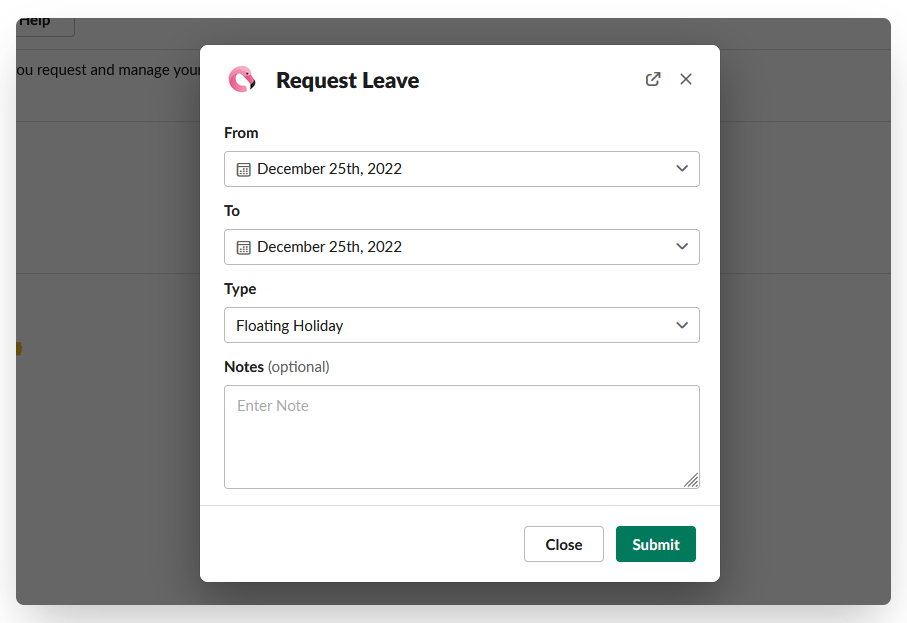April 16, 2024
HR Teams and Managers’ Guide to Leave Planning
An efficient leave planning process is vital if you want to allow your employees to take time off without cau...

In this article we’re going to look at everything to do with floating holidays. By the end, you’ll know what a floating holiday is, and when it makes sense to provide floating holidays in your business.
We’ll examine:
Whether you’re an HR professional, founder, department manager, or you’re just interested in the topic, keep reading for all you need to know about floating holidays.
Further Reading: All you need to know about Flexible Time Off and similar leave policies.
A floating holiday is a paid day off that is not tied to a specific date. It’s usually given for national holidays, religious holidays or as paid holidays for cultural events. But unlike a typical public holiday, the employee can choose when they want to take this day off.
Floating holidays are very similar to regular paid time off (PTO) and paid public holidays. However, offering floating holidays in certain situations (which we’ll look at below) can offer greater flexibility for employees, and help build a more inclusive, diverse and welcoming workplace.
Learn More: the most common and most highly valued employee benefits in today’s workplaces.
For all intents and purposes, floating holidays work just like PTO.
There may be small differences for each workplace in the process by which someone takes a floating holiday. But essentially, these days off are added to an employee’s leave quota, and to take a floating holiday, the employee goes through the time off request process as per normal.
Like PTO or a public holiday, a floating holiday gives the employee a day off from work, paid out at their regular daily or hourly wage.
Now let’s look at what situations someone might receive a floating holiday.
There’s no strict definition for when a floating holiday should be given. You’ll find it varies from workplace to workplace. It can be an earned benefit or a compensatory benefit. The usage of floating holidays really comes down to how a company chooses to set up their leave policy.
Here are some of the most common floating holiday use cases (expand to learn more).
Floating holidays may be offered as a replacement for government or national holidays, such as Christmas, New Year’s Day, Memorial Day, etc. This is common for distributed/remote teams, where employees located across the world celebrate different public holidays. Instead of following a shared public holiday calendar, each person gets a set number of floating holidays they can take whenever they wish.
A floating holiday may be given for employees who have to work on a public holiday. Service industry workers, for example, may be required to work on a holiday. In exchange for this, they’ll get a floating holiday that they can use to take their paid holiday on another day.
A company may have employees from diverse cultural and religious backgrounds. As such, not all employees will observe Easter or Christmas, for example. Instead of providing these holidays as a day off for all staff, the company may give each person a floating holiday, allowing them to celebrate the religious holidays of their own choosing.
When employees work overtime or come in on their day off, floating holidays may act as part of the overtime compensation – a paid day off at a later date, to make up for the extra hours they had to work.
Employees may accrue or earn floating holidays as an additional employee benefit. An employee may receive a floating holiday for a certain length of service with the company, as a performance bonus, or a reward for reaching certain milestones.
It’s also common to see floating holidays given for someone’s birthday. Maybe each employee gets their birthday off, but those whose birthday falls on the weekend receive a floating holiday instead, to keep it fair. Or it may work with every employee receiving a floating holiday for their birthday, allowing them to take it on their actual birthday or another day that suits them better.
Related Reading: 55% of US Employees Don’t Use Their PTO. Find out why, and what you can do to ensure your staff take enough time off.
Floating holidays are generally separate from PTO, but work in much the same way.
There’s no fundamental difference to a floating holiday vs PTO. Each functions as a paid day off for the employee. There’s not a lot of difference if the company chooses to add a day to the employee’s PTO quota or provide a floating holiday instead.
There are some small differences that may come up. Typically floating holidays expire at the end of the year, while PTO usually rolls over to the following year.
Floating holidays also can’t be cashed out when the employee leaves the company. They also don’t go by the same accrual or service time rules as PTO. They’re available to the employee right away, whereas PTO may only become available after a certain length of time working in the business.
These differences may not all apply the same in every company, however. It’s really up to how each organization chooses to approach it in their own leave policy.
There are a number of benefits to offering floating holidays. The benefits of floating holidays vs PTO are more or less the same. Floating holidays just offer a bit more of a symbolic gesture, and have additional benefits when it comes to promoting a sense of fairness and diversity in the workplace.
Here’s a quick breakdown.
Further Reading: learn how much PTO is average in the US and around the world, and craft your leave policy accordingly.
Let’s answer some frequently asked questions about floating holidays.
In the United States, there are no laws that regulate floating holidays. Whether you offer floating holidays, and how many days, would depend on your company’s time off policy. Some other countries, however, do have laws that relate to floating holidays and compensatory time off for public holidays. Go here to learn more about leave laws in your location.
It’s up to each company’s leave policy how this works. Generally, it’s fine to have two floating holidays (or more) banked up, but some companies may insist that an employee must use their holiday before they can get another one.
This again depends on the company’s policy. Most of the time, floating holidays expire at the end of the year. This is not always the case though – and it’s important to note the “use it or lose it” laws in your area, as it may be a legal requirement in some places to allow floating holidays to carry over.
This depends again on the leave policy. Sometimes, unused floating holidays simply disappear at the end of the year or upon termination of employment. In others, they can accrue indefinitely, and may function exactly like vacation days or PTO.
Trending: Key Unlimited PTO Statistics to know in 2024.
As part of the company’s leave policy or employee handbook, there should be a floating holiday policy stating how floating holidays work.
This should include:
It’s important to spell everything out in the floating holiday policy, to avoid any issues or accusations of unfairness, and to ensure everyone comes in with clear expectations.
Like with any kind of paid time off, you need to set up a system to keep track of floating holidays.
You need to know who has floating holidays available, how many each has, and keep track of which dates each person plans to take their floating holidays.
A simple spreadsheet may do the job for very small teams. But it can get complicated as your team grows, and you have more holidays to track.
That’s why an automated leave management software like Flamingo is so valuable. Flamingo is built specifically for modern, remote teams, and makes keeping track of vacation time, sick time, floating holidays and all other leave types simple and stress-free.
Team members can see how many available days off they have, and request a floating holiday, directly within Slack.

Managers can view and approve leave requests in Slack as well, keeping your leave management system entirely within your existing workflow.
All leaves are added to an easy-to-view vacation calendar that keeps your schedule organized and up-to-date.

All teams need a tool like Flamingo to remove the complexity of managing leave, and allow ample time off in your employee benefits package without letting it disrupt productivity.
In this post, we’ve answered the question “what does a floating holiday mean”, in the context of your business.
Floating holidays are a flexible and powerful tool to enhance employee wellness. Offering floating holidays is a great way to ensure your work environment is fair, equal, and inclusive. It’s also a nice thing to add to your employee benefits package. A floating holiday is a powerful reward to encourage employees to give their all for the company.
Aside from what state laws require, there may be some good opportunities to offer floating holidays to your employees. Read up on the common scenarios we outlined in this post, and make your business a more positive work environment.
Flamingo makes managing your team’s paid time off a breeze.